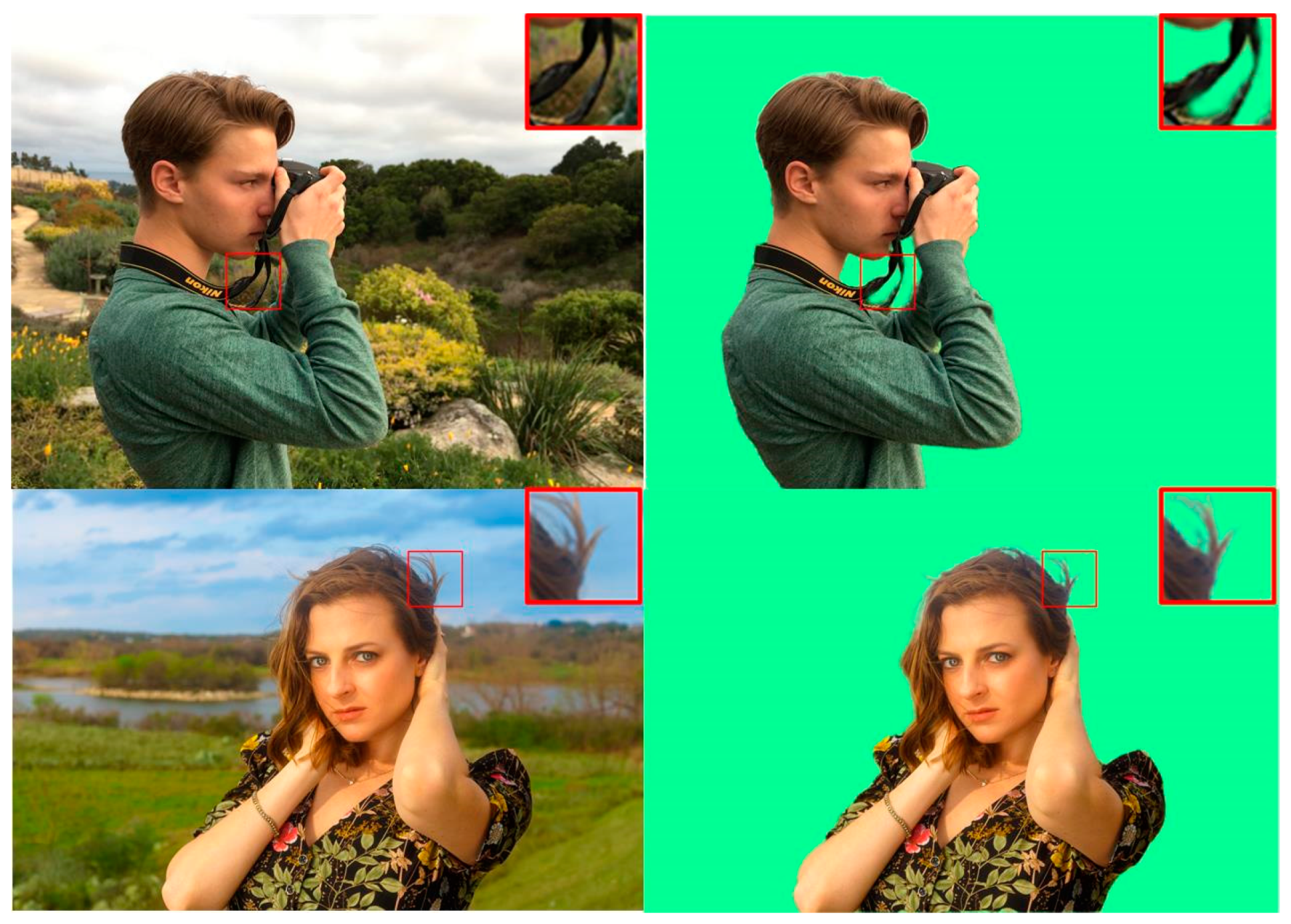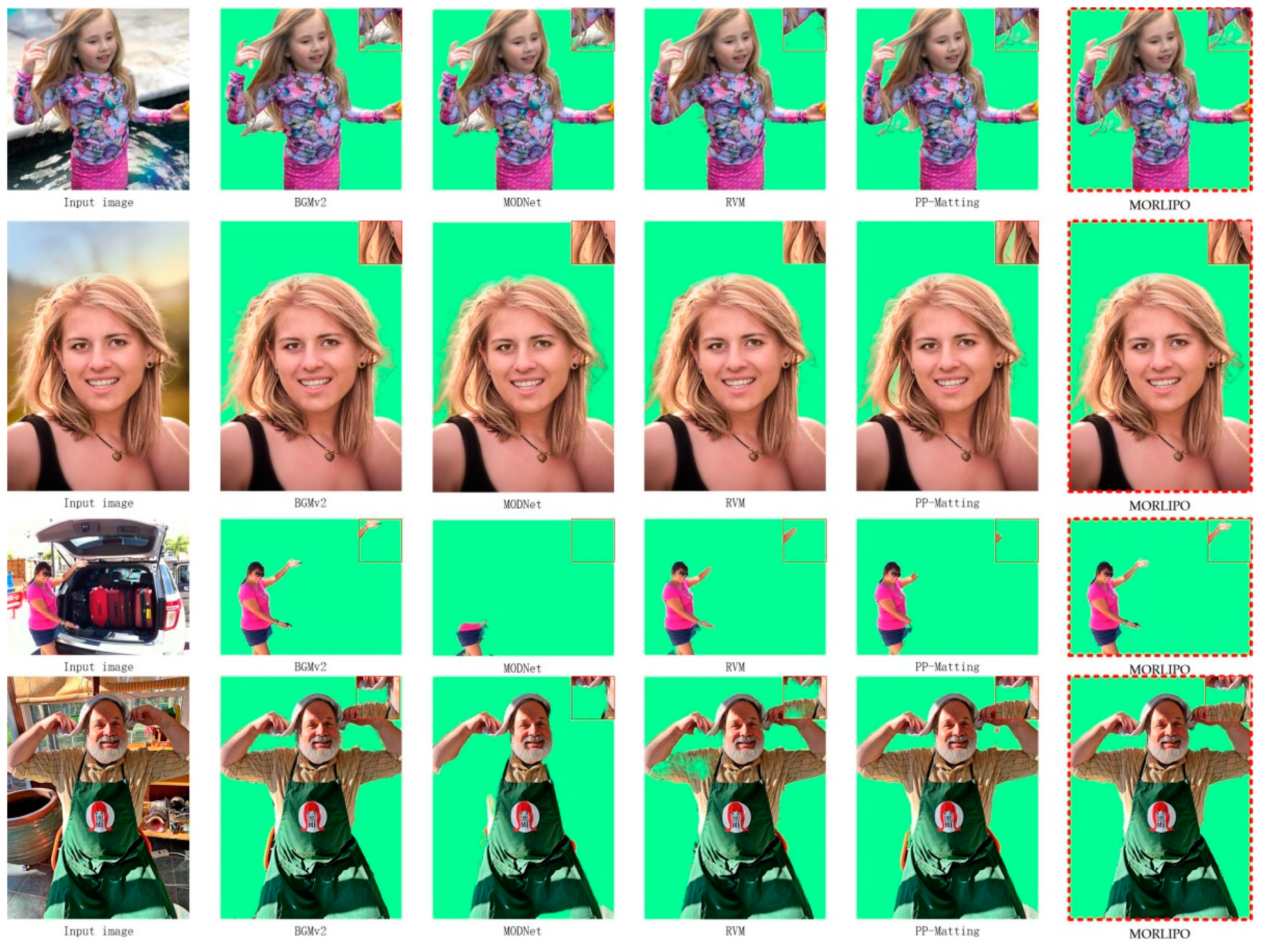Matting Algorithm with Improved Portrait Details for Images with Complex Backgrounds
Abstract
1. Introduction
- We propose a method that combines background restoration and acquisition of fine-grained matting to simultaneously improve the performance of image matting from two aspects.
- We incorporate an ultralightweight model for image matting in complex backgrounds that achieves an optimal trade-off between performance and inference speed. Extensive evaluation of the data set demonstrates the superiority of our model.
2. Related Work
2.1. Image Matting
2.2. Video Matting
2.3. Scene Background Modeling
3. Method
3.1. Architecture of the Backbone Network
3.2. Background Restoration Module
3.3. Fine-Grained Detail Matting
3.4. Loss Function
4. Experiments
4.1. Data Set
4.2. Methods for Comparsion
4.3. Analysis of Experimental Results
5. Conclusions
Author Contributions
Funding
Data Availability Statement
Acknowledgments
Conflicts of Interest
References
- Huang, L.; Liu, X.; Wang, X.; Li, J.; Tan, B. Deep Learning Methods in Image Matting: A Survey. Appl. Sci. 2023, 13, 6512. [Google Scholar] [CrossRef]
- Li, J.; Zhang, J.; Tao, D. Deep Image Matting: A Comprehensive Survey. arXiv 2023, arXiv:2304.04672. [Google Scholar]
- Liu, J.; Yao, Y.; Hou, W.; Cui, M.; Xie, X.; Zhang, C.; Hua, X.S. Boosting semantic human matting with coarse annotations. In Proceedings of the IEEE Computer Vision and Pattern Recognition, Seattle, WA, USA, 13–19 June 2020; pp. 8563–8572. [Google Scholar]
- Fang, X.; Zhang, S.H.; Chen, T.; Wu, X.; Shamir, A.; Hu, S.M. User-guided deep human image matting using arbitrary trimaps. IEEE Trans. Image Process. 2022, 31, 2040–2052. [Google Scholar] [CrossRef]
- Li, J.; Zhang, J.; Tao, D. Referring image mattin. In Proceedings of the IEEE/CVF Conference on Computer Vision and Pattern Recognition, Vancouver, BC, Canada, 18–22 June 2023; pp. 22448–22457. [Google Scholar]
- Sengupta, S.; Jayaram, V.; Curless, B.; Seitz, S.M.; Kemelmacher-Shlizerman, I. Background matting: The world is your green screen. In Proceedings of the IEEE/CVF Conference on Computer Vision and Pattern Recognition, Seattle, WA, USA, 13–19 June 2020; pp. 2291–2300. [Google Scholar]
- Lin, S.; Ryabtsev, A.; Sengupta, S.; Curless, B.L.; Seitz, S.M.; Kemelmacher-Shlizerman, I. Real-time high-resolution background matting. In Proceedings of the IEEE/CVF Conference on Computer Vision and Pattern Recognition, Nashville, TN, USA, 20–25 June 2021; pp. 8762–8771. [Google Scholar]
- Zou, D.; Chen, X.; Cao, G.; Wang, X. Unsupervised video matting via sparse and low-rank representation. IEEE Trans. Pattern Anal. Mach. Intell. 2019, 42, 1501–1514. [Google Scholar] [CrossRef]
- Sun, Y.; Wang, G.; Gu, Q.; Tang, C.K.; Tai, Y.W. Deep video matting via spatio-temporal alignment and aggregation. In Proceedings of the IEEE/CVF Conference on Computer Vision and Pattern Recognition, Nashville, TN, USA, 20–25 June 2021; pp. 6975–6984. [Google Scholar]
- Kong, Y.; Li, J.; Hu, L.; Li, X. Semi-Supervised Learning Matting Algorithm Based on Semantic Consistency of Trimaps. Appl. Sci. 2023, 13, 8616. [Google Scholar] [CrossRef]
- Song, S. Attention based Memory video portrait matting. In Proceedings of the IEEE/CVF Conference on Computer Vision and Pattern Recognition, New Orleans, LA, USA, 18–24 June 2022. [Google Scholar]
- Lin, S.; Yang, L.; Saleemi, I.; Sengupta, S. Robust high-resolution video matting with temporal guidance. In Proceedings of the IEEE/CVF Winter Conference on Applications of Computer Vision, Waikoloa, HI, USA, 3–8 January 2022; pp. 238–247. [Google Scholar]
- Ke, Z.; Sun, J.; Li, K.; Yan, Q.; Lau, R.W. Modnet: Real-time trimap-free portrait matting via objective decomposition. AAAI Conf. Artif. Intell. 2022, 36, 1140–1147. [Google Scholar] [CrossRef]
- Sun, J.; Ke, Z.; Zhang, L.; Lu, H.; Lau, R.W.H. Modnet-v: Improving portrait video matting via background restoration. In Proceedings of the IEEE Conference on Computer Vision and Pattern Recognition, Nashville, TN, USA, 20–25 June 2021. [Google Scholar]
- Chen, G.; Liu, Y.; Wang, J.; Peng, J.; Hao, Y.; Chu, L. Pp-matting: High-accuracy natural image matting. In Proceedings of the IEEE/CVF Conference on Computer Vision and Pattern Recognition, New Orleans, LA, USA, 18–24 June 2022. [Google Scholar]
- Gu, Z.; Xian, W.; Snavely, N.; Davis, A. Factormatte: Redefining video matting for re-composition tasks. ACM Trans. Graph. (TOG) 2023, 42, 1–14. [Google Scholar] [CrossRef]
- Cho, D.; Tai, Y.W.; Kweon, I. Natural image matting using deep convolutional neural networks. In Proceedings of the Computer Vision ECCV 2016: 14th European Conference, Amsterdam, The Netherlands, 11–14 October 2016; pp. 626–643. [Google Scholar]
- Levin, A.; Rav-Acha, A.; Lischinski, D. Spectral matting. IEEE Trans. Pattern Anal. Mach. Intell. 2008, 30, 1699–1712. [Google Scholar] [CrossRef] [PubMed]
- Chen, Q.; Li, D.; Tang, C.K. KNN matting. IEEE Trans. Pattern Anal. Mach. Intell. 2013, 35, 2175–2188. [Google Scholar] [CrossRef]
- Liu, X.; Zhang, Z.; Hao, Y.; Zhao, H.; Yang, Y. Optimized OTSU Segmentation Algorithm-Based Temperature Feature Extraction Method for Infrared Images of Electrical Equipment. Sensors 2024, 24, 1126. [Google Scholar] [CrossRef] [PubMed]
- Xu, N.; Price, B.; Cohen, S.; Huang, T. Deep image matting. In Proceedings of the IEEE Conference on Computer Vision and Pattern Recognition, Honolulu, HI, USA, 21–26 June 2017; pp. 2970–2979. [Google Scholar]
- Yang, Y.; Gou, H.; Tan, M.; Feng, F.; Liang, Y.; Xiang, Y.; Wang, L.; Huang, H. Multi-criterion sampling matting algorithm via gaussian process. Biomimetics 2023, 8, 301. [Google Scholar] [CrossRef] [PubMed]
- Qiao, Y.; Liu, Y.; Yang, X.; Zhou, D.; Xu, M.; Zhang, Q.; Wei, X. Attention-guided hierarchical structure aggregation for image matting. In Proceedings of the IEEE/CVF Conference on Computer Vision and Pattern Recognition, Seattle, WA, USA, 13–19 June 2020; pp. 13676–13685. [Google Scholar]
- Zhang, Y.; Gong, L.; Fan, L.; Ren, P.; Huang, Q.; Bao, H.; Xu, W. A late fusion cnn for digital matting. In Proceedings of the IEEE/CVF Conference on Computer Vision and Pattern Recognition, Long Beach, CA, USA, 15–20 June 2019; pp. 7469–7478. [Google Scholar]
- Shen, X.; Tao, X.; Gao, H.; Zhou, C.; Jia, J. Deep automatic portrait matting. In Proceedings of the Computer Vision–ECCV 2016: 14th European Conference, Amsterdam, The Netherlands, 11–14 October 2016; pp. 92–107. [Google Scholar]
- Zhang, X.; Wang, G.; Chen, C.; Dong, H.; Shao, M. Semi-Supervised Portrait Matting via the Collaboration of Teacher–Student Network and Adaptive Strategies. Electronics 2022, 1, 4080. [Google Scholar] [CrossRef]
- Li, J.; Henschel, R.; Goel, V.; Ohanyan, M.; Navasardyan, S.; Shi, H. Video Instance Matting. In Proceedings of the IEEE/CVF Conference on Computer Vision and Pattern Recognition, Vancouver, BC, Canada, 18–22 June 2023. [Google Scholar]
- Elcott, S.; Lewis, J.P.; Kanazawa, N.; Bregler, C. Training-Free Neural Matte Extraction for Visual Effects. In Proceedings of the IEEE/CVF Conference on Computer Vision and Pattern Recognition, Vancouver, BC, Canada, 18–22 June 2023. [Google Scholar]
- Ke, Z.; Li, K.; Zhou, Y.; Wu, Q.; Mao, X.; Yan, Q. Is a green screen really necessary for real-time portrait matting. arXiv 2020, arXiv:2011.11961. [Google Scholar]
- Sidibé, D.; Strauss, O.; Puech, W. Automatic background generation from a sequence of images based on robust mode estimation. In Digital Photography V; SPIE: Bellingham, WA, USA, 2009; pp. 214–222. [Google Scholar]
- Laugraud, B.; Piérard, S.; Van Droogenbroeck, M. LaBGen: A method based on motion detection for generating the background of a scene. Pattern Recognit. Lett. 2017, 96, 12–21. [Google Scholar] [CrossRef]
- Laugraud, B.; Piérard, S.; Van Droogenbroeck, M. Labgen-p-semantic: A first step for leveraging semantic segmentation in background generation. J. Imaging 2018, 4, 86. [Google Scholar] [CrossRef]
- Djerida, A.; Zhao, Z.; Zhao, J. Robust background generation based on an effective frames selection method and an efficient background estimation procedure (FSBE). Signal Process. Image Commun. 2019, 78, 21–31. [Google Scholar] [CrossRef]
- Kajo, I.; Kamel, N.; Ruichek, Y. Self-motion-assisted tensor completion method for background initialization in complex video sequences. IEEE Trans. Image Process. 2019, 29, 1915–1928. [Google Scholar] [CrossRef]
- Kim, J.Y.; Ha, J.E. Generation of background model image using foreground model. IEEE Access 2021, 9, 127515–127530. [Google Scholar] [CrossRef]
- Sauvalle, B.; de La Fortelle, A. Fast and Accurate Background Reconstruction Using Background Bootstrap. J. Imaging 2022, 8, 9. [Google Scholar] [CrossRef]
- Xu, P.; Ye, M.; Li, X.; Liu, Q.; Yang, Y.; Ding, J. Dynamic background learning through deep auto-encoder networks. In Proceedings of the 22nd ACM International Conference on Multimedia, Orlando, FL, USA, 3–7 November 2014; pp. 107–116. [Google Scholar]
- Rhemann, C.; Rother, C.; Wang, J.; Gelautz, M.; Kohli, P.; Rott, P. A perceptually motivated online benchmark for image matting. In Proceedings of the 2009 IEEE Conference on Computer Vision and Pattern Recognition, Miami, FL, USA, 20–25 June 2009; pp. 1826–1833. [Google Scholar]
- Zhang, H.; Zhang, J.; Perazzi, F.; Lin, Z.; Patel, V.M. Deep image compositing. In Proceedings of the IEEE/CVF Winter Conference on Applications of Computer Vision, Waikoloa, HI, USA, 5–9 January 2021; pp. 365–374. [Google Scholar]
- Wang, L.; Ye, X.; Ju, L.; He, W.; Zhang, D.; Wang, X.; Huang, Y.; Feng, W.; Song, K.; Ge, Z. Medical matting: Medical image segmentation with uncertainty from the matting perspective. Comput. Biol. Med. 2023, 158, 106714. [Google Scholar] [CrossRef] [PubMed]
- Ma, D.; Wu, R.; Xiao, D.; Sui, B. Cloud Removal from Satellite Images Using a Deep Learning Model with the Cloud-Matting Method. Remote Sens. 2023, 15, 904. [Google Scholar] [CrossRef]
- Husain, A.; Maity, T.; Yadav, R.K. Vehicle detection in intelligent transport system under a hazy environment: A survey. IET Image Process. 2020, 14, 1–10. [Google Scholar] [CrossRef]
- Maqsood, S.; Damasevicius, R.; Siłksa, J.; Woźniak, M. Multimodal image fusion method based on multiscale image matting. In Proceedings of the International Conference on Artificial Intelligence and Soft Computing, Online, 29–30 January 2021; pp. 57–68. [Google Scholar]




| Method | Backbone | MAD | MSE | Grad | Conn |
|---|---|---|---|---|---|
| BGMv2 | MobileNetV2 | 33.90 | 28.39 | 2.38 | 4.52 |
| MODNet | MobileNetV2 | 7.36 | 2.6 | 1.58 | 0.60 |
| RVM | MobileNetV3 | 6.36 | 1.47 | 1.03 | 0.45 |
| PP-Matting | MobileNetV3 | 5.91 | 1.21 | 0.76 | 0.39 |
| MORLIPO | MobileNetV2 | 5.81 | 1.20 | 0.50 | 0.39 |
| Method | Backbone | MAD | MSE | Grad | Conn |
|---|---|---|---|---|---|
| BGMv2 | MobileNetV2 | 31.80 | 30.32 | 32.40 | 5.31 |
| MODNet | MobileNetV2 | 24.04 | 15.53 | 38.88 | 4.28 |
| RVM | MobileNetV3 | 27.50 | 21.31 | 34.18 | 2.12 |
| PP-Matting | MobileNetV3 | 20.03 | 14.32 | 33.45 | 0.49 |
| MORLIPO | MobileNetV2 | 20.01 | 13.49 | 33.40 | 0.47 |
Disclaimer/Publisher’s Note: The statements, opinions and data contained in all publications are solely those of the individual author(s) and contributor(s) and not of MDPI and/or the editor(s). MDPI and/or the editor(s) disclaim responsibility for any injury to people or property resulting from any ideas, methods, instructions or products referred to in the content. |
© 2024 by the authors. Licensee MDPI, Basel, Switzerland. This article is an open access article distributed under the terms and conditions of the Creative Commons Attribution (CC BY) license (https://creativecommons.org/licenses/by/4.0/).
Share and Cite
Li, R.; Zhang, D.; Geng, S.-L.; Zhou, M.-Q. Matting Algorithm with Improved Portrait Details for Images with Complex Backgrounds. Appl. Sci. 2024, 14, 1942. https://doi.org/10.3390/app14051942
Li R, Zhang D, Geng S-L, Zhou M-Q. Matting Algorithm with Improved Portrait Details for Images with Complex Backgrounds. Applied Sciences. 2024; 14(5):1942. https://doi.org/10.3390/app14051942
Chicago/Turabian StyleLi, Rui, Dan Zhang, Sheng-Ling Geng, and Ming-Quan Zhou. 2024. "Matting Algorithm with Improved Portrait Details for Images with Complex Backgrounds" Applied Sciences 14, no. 5: 1942. https://doi.org/10.3390/app14051942
APA StyleLi, R., Zhang, D., Geng, S.-L., & Zhou, M.-Q. (2024). Matting Algorithm with Improved Portrait Details for Images with Complex Backgrounds. Applied Sciences, 14(5), 1942. https://doi.org/10.3390/app14051942






